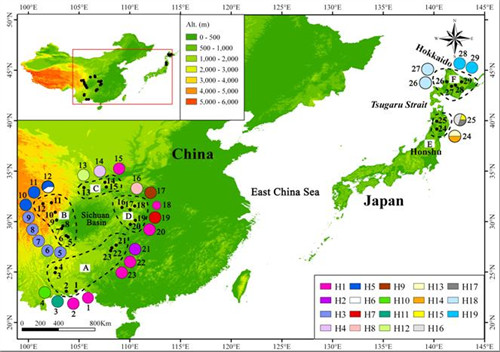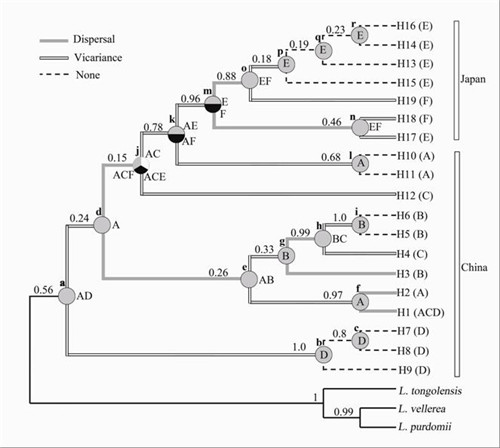Many temperate angiosperm genera exhibit disjunct distribution patterns among Asia, North America and Europe, with the most common studied disjunction pattern being eastern Asia–eastern North America. Within Asia, many plant species researched show a disjunct distribution between China and Japan. To date, there have been a few phylogeographical studies of the origins of disjunct distributions in eastern China and Japan. However, no studies have been conducted to elucidate the origin of plant species with the Southwestern and Central China-Japan disjunction.
Recently, Doc. Wang Jingfeng, supervised by Prof. Gong Xun, from Kunming Institute of Botany, sampled Ligularia hodgsonii, which exhibits a disjunct distribution between south-western–central China and Japan, to elucidate the phylogenetic origins and phylogeographical history of this species. Three chloroplast DNA spacers regions (trnQ-5’rps16, trnL-rpl32, and psbA-trnH) were sequenced in 280 individuals isolated from 29 natural populations, including 23 from China and six from Japan. Main progress is as follows.
Genetic variation in cpDNA revealed 19 unique haplotypes among populations. A high degree of genetic diversity and a significant level of differentiationwere detected.Different haplotypes between continental and island populations were resolved, and the degree of genetic diversity observed within each of the two regions was similar. S-DIVA analysis supported a L. hodgsonii vicariance event between the continental and island areas.
RASP analysis, non-overlapping cpDNA haplotypes, and similar genetic diversity levels in continental and island populations were consistent with our hypothesis that the disjunct distribution of L. hodgsonii is the result ofvicariance. Molecular dating suggested that the vicariance between the islands of Japan and mainland Asia occurred during the middle-late Pleistocene. Following divergence, L. hodgsonii populations likely underwent severe range contraction and extinction during the last glacial maximum (LGM) due to lower temperatures and drier conditions.Finally, multiple isolated glacial refugia were detected that allowed L. hodgsonii to survive throughout the cyclical glacial epoch.
This paper has been online published in the international Journal Journal of Biogeography (http://onlinelibrary.wiley.com/doi/10.1111/jbi.12114/abstract).
This work was supported by grants from the National Science Foundation of China (2007CB411600).

Sample locations and cpDNA haplotype distributionand frequency for L. hodgsonii. Pie charts show the frequency of haplotypes in each population.

Phylogenetic relationships of the cpDNA haplotypesof L.hodgsonii (H1-H19) generated by BEAST. Posterior probabilities are shown above the branches. Pie charts indicate the proportion of the ancestral ranges based on the statistical dispersal-vicariance analysis (S-DIVA).




